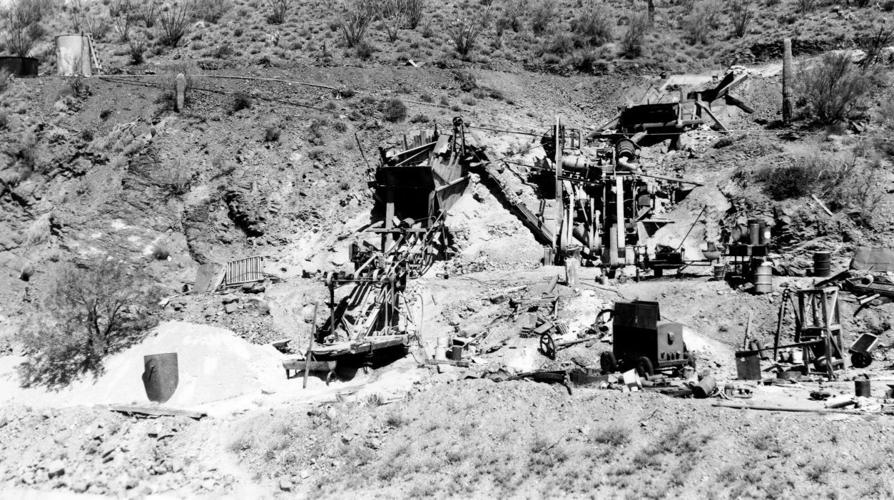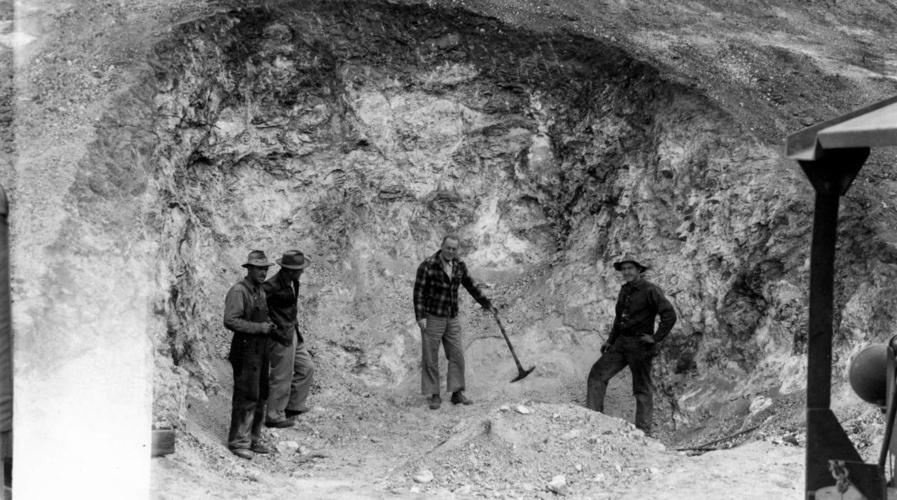Arizona hosts a significant quantity of pegmatite mineral deposits that have served as commercial sources of beryl, feldspar, lithium, mica, tantalum-columbium minerals, tungsten and quartz.
Pegmatites are coarse-grained igneous rocks containing large crystals at least 1 centimeter in diameter. Composed of feldspar, mica and quartz, pegmatites are formed by the final stages of the crystallization of magma. They are sought after because of their valuable mineral and gemstone content.
Significant production in Arizona began after World War II, as lithium-bearing pegmatites were extensively sought after leading to the discovery of the Arizona pegmatite belt extending from Lake Mead south to Kingman and southeast to Wickenburg, measuring 250 miles in length and averaging 55 miles in width.
Located 10 miles east of Wickenburg and 45 miles northwest of Phoenix, the White Picacho District is in the southern part of the Arizona pegmatite belt, encompassing an area of 150 miles in Maricopa and Yavapai counties.
The Midnight Owl Mine, also known as the Lithia King, is one of the prominent mines in the district known for its lithium deposits. Lithium, a silvery-white metal, is the lightest of all solid elements, having the quality of floating on gasoline. It occurs in percentages of less that 10 percent in amblygonite, lepidolite and spodumene. However, when alloyed with magnesium, it takes on the properties of hardness, including uses in armor plate.
Lithium salts have uses including in the manufacture of glass, alkaline storage batteries, and as a carbon dioxide absorbent in submarines.
Worked by brothers Earl F. and Sidney B. Anderson, who were public school teachers in Phoenix, the Midnight Owl Mine comprised five unpatented claims. With the erection of a mica mill in 1947, production began featuring open-cut methods. Between 1947 and 1952, 62 tons of amblygonite and 13 tons of beryl, along with columbite-tantalite concentrate, were mined and processed from the Midnight Owl Mine.
Earl Anderson apparently ran into financial difficulties in the summer of 1952. An advance payment by the Alreco Metal Corp. for a bulldozer, along with an agreed-upon shipment of 200 tons of amblygonite, a lithium-sodium aluminum fluophosphate from the mine, never materialized. The company asserted in a letter to Arthur L. Flagg, office engineer for the Arizona Department of Mineral Resources, a formal complaint regarding the matter, threatening legal action, asserting that Anderson used the company’s remittance for payment toward satisfying his old debts. Flagg responded with confidence in Anderson’s stockpile of amblygonite in pegmatite dikes on his property, however, confirming that he could exert no influence on Anderson’s business.
A 1958 report cited that the mine produced several carloads of spodumene, along with amblygonite, beryl, columite and tantalite. Multiple companies involved in the procurement arrangement included the Maywood Chemical Co, Foote Mineral Co., the government depot at Rapid City, South Dakota, Mike Lyon of Arvada, Colorado, and an unnamed buyer in Germany.
Mining activity during the 1980s involved a test lot of ore recovery involving a pilot gravity mill used to recover tantalum and other metals from the Midnight Owl Mine and nearby Homestead and Outpost mines.
The mill included assorted crushing and grinding equipment, along with a Wilfley table used to separate heavy mineral particles from worthless rock.
Drawn by the high-quality feldspar reserves in the White Picacho District, the Sid Anderson properties were acquired by Fansteel Corp. in 1987, which in turn leased the 12 mining claims comprising 340 acres to Steelhead Resources, Ltd.
Dick and Mardy Zimmerman currently own claims at the Midnight Owl Mine, having generously hosted mineral-collecting trips for local mineral clubs. The mine is credited with a mixture of rare and microscopic minerals.
Fluorescent minerals from the Midnight Owl Mine include eucryptite, a lithium-aluminum silicate found in massive gray pegmatite rock.
William Ascarza is an archivist, historian and author of seven books available for purchase online and at select bookstores. These include his latest, “In Search of Fortunes: A Look at the History of Arizona Mining,” available through M.T. Publishing Co. at tucne.ws/7ka. His other books are “Chiricahua Mountains: History and Nature,” “Southeastern Arizona Mining Towns,” “Zenith on the Horizon: An Encyclopedic Look at the Tucson Mountains from A to Z,” “Tucson Mountains,” “Arizona-Sonora Desert Museum” with Peggy Larson and “Sentinel to the North: Exploring the Tortolita Mountains.” Email Ascarza at mining@azstarnet.com





